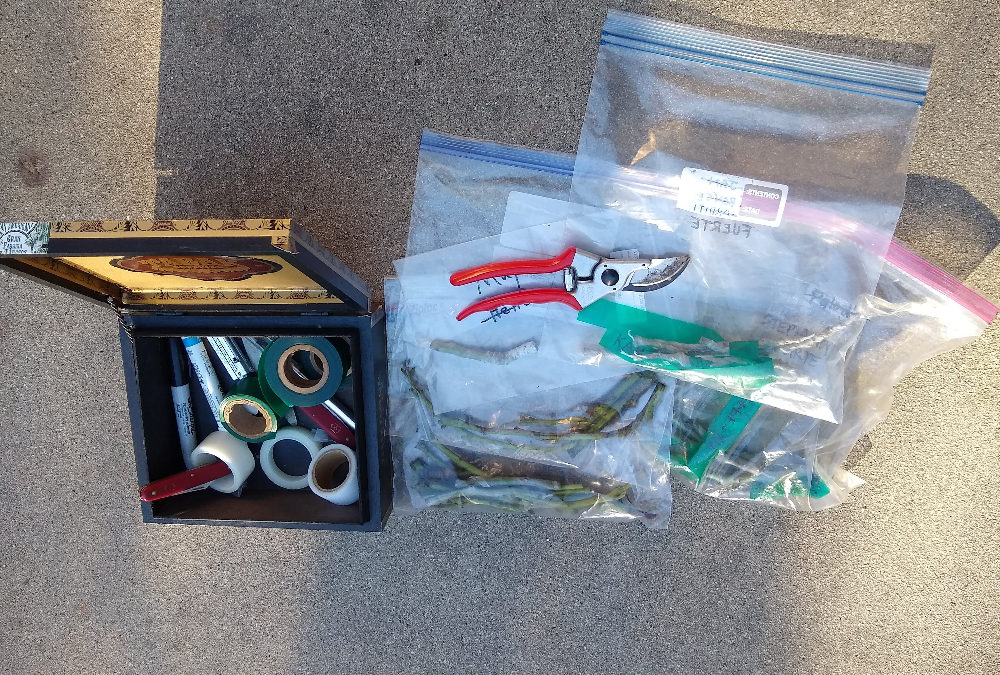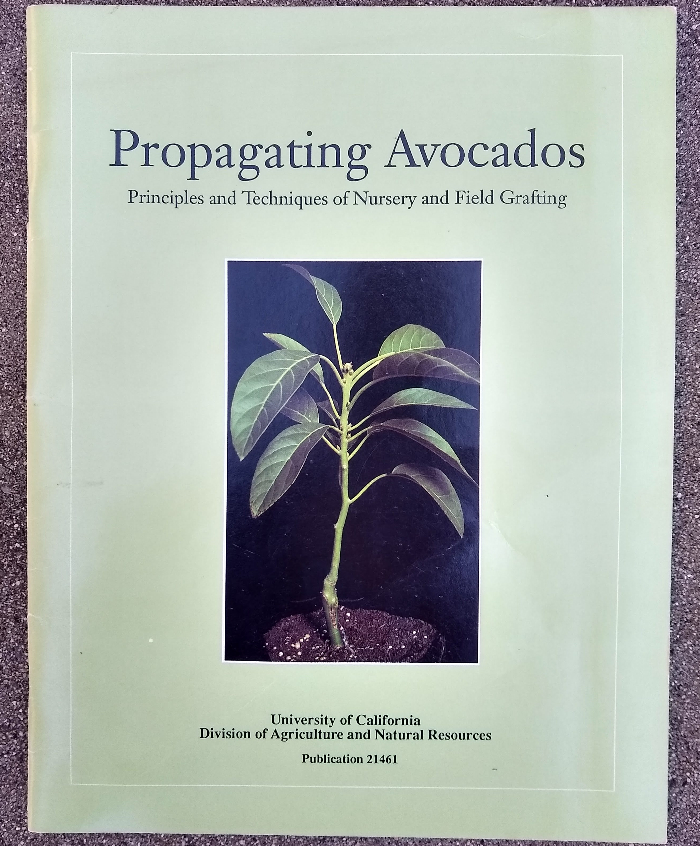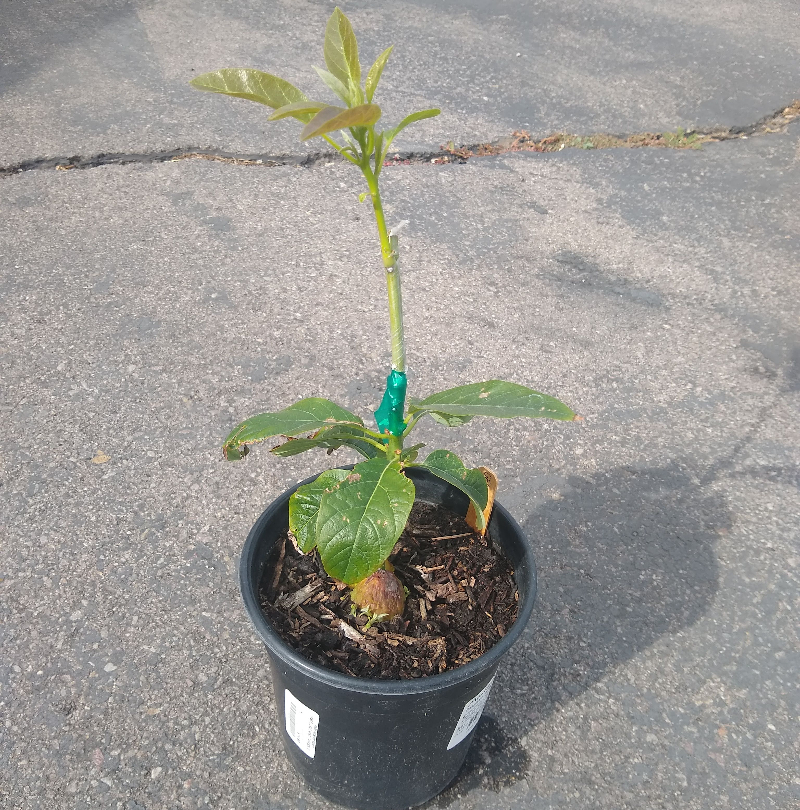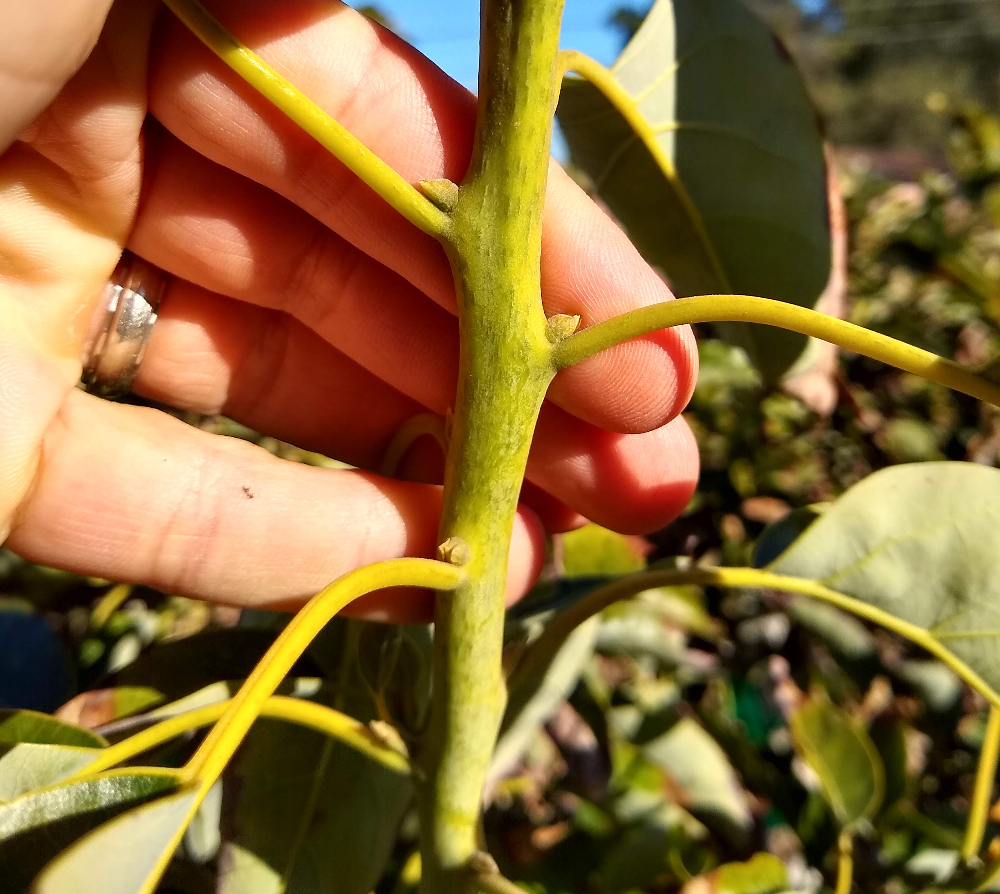The skill of grafting empowers you. Being able to graft gives you options. Nursery doesn’t have a Sharwil tree for sale? If you can get your hands on a Sharwil scion, then you can make your own. Just moved into a house with a big avocado tree that makes inferior fruit? Cut it back and graft it over to your variety of choice, and you’ll have a big tree full of your favorite avocados in only a couple years.
My aim in this post is twofold: to connect you to the best resources about grafting avocados, and to share tips in areas where I’ve made mistakes over the years.
1. Best resources
Books:
There is one book about grafting avocados: “Propagating Avocados: Principles and Techniques of Nursery and Field Grafting” by Whitsell, Martin, Bergh, Lypps, and Brokaw.
It’s actually a 30-page pamphlet published in 1989 by the University of California. It can be downloaded for free (and printed, if you like) from the UC website here or from Avocadosource here.
“Propagating Avocados” has many excellent photographs and drawings, and I reread it a couple times every year. It was written by a group of people with vast experience on the subject.
Videos:
A web search for videos on grafting avocados turns up many results. I’ve watched a good portion of them. There are a handful that are worth your time. Here are three that are most worthy of your time.
Gray Martin
Gray Martin is one of the authors of “Propagating Avocados,” and he has made a series of videos about grafting avocados, specifically on topworking (changing a big tree over to a new variety).
Start with his video about “Selecting avocado budwood,” and continue following his process for an entire year with the rest of his videos.
(Martin also wrote this provocative article with Bob Bergh: “Avocado Topworking Update 1990.”)
Ty McDonald
Ty McDonald slowly and clearly walks you through how to do a side graft on a young seedling avocado tree. In Ty McDonald 1, he talks about why we graft, tools to use, and methods to choose from. In Ty McDonald 2, he performs a side graft to transform a seedling into a Sharwil.
Lynwood Nursery
To see how tip grafting is done on very small seedlings in a commercial greenhouse setting, this video about Lynwood Nursery in New Zealand is worth watching. You’ll see things that will help you do your own tip grafting at home.
2. Notes on grafting avocados
Wrapping budwood
The first time I wrapped a scion with Parafilm, an old timer named Jim Neitzel was guiding me. I had wrapped too thickly. Ideally, Neitzel pointed out, you want only one thin layer of Parafilm over each bud. This way the moisture stays in, but the bud also has no problem breaking through the Parafilm as it grows out. That lesson has stuck with me and yielded good grafting results in the years since. Only one layer of Parafilm over a bud.
Sunlight unnecessary
When tip-grafting small trees in containers, it is not necessary to keep the newly grafted tree in the sunshine. In fact, unless it is winter and the sun is very weak, it is far safer to keep the newly grafted tree in some amount of shade until the graft has healed and the scion has grown out a few inches.
This should especially be kept in mind in summer. Keep newly grafted trees out of the strong sun until they have grown leaves to shade their stems and trunk.
I have grafted successfully during 100-degree days in August through keeping the newly grafted tree in shade.
Best time of year to graft
March is usually the magic month in Southern California. Why do avocado grafts do well at that time? It has warmed up a little and trees have started to grow. February can also be a very good month, as can early April — it depends on the year’s weather.
But this is for grafts done outside. If you use a greenhouse or a shade structure, then time of year doesn’t matter nearly as much.
Best time of year to collect avocado scions
March is not always the best time to collect avocado budwood though. It is sometimes better to collect scions earlier.
The best avocado budwood has plump and green buds which are still dormant. You can often find such budwood on any given day of the year, but it is usually most plentiful in the winter after trees have paused growing and before they resume growing.
If a tree has good budwood for the taking but the stock you want to graft onto is not ready, you can store the scions in the fridge for at least a month, sometimes many months, without their losing viability.
How long should avocado scions be? Many people use sticks that are about six inches long, but I tend to use shorter ones. If a scion has two good buds, I’m happy and get fine results.
Curiously, back in 1960 some researchers found that scions closer to six inches had better take compared to scions about three inches long. See the discussion about scion length (and time of year to collect) in “Some Factors Influencing Grafting Success with Avocados” by Rodrigues, Ryan, and Frolich. Despite this finding, I continue to use mostly shorter scions, but maybe I’m a fool.
Storing avocado budwood
To get the most life from an avocado scion, you want to keep it cool and to prevent it from drying. Placing the stick in a plastic bag, and placing the bag in the fridge works perfectly.
Some people put damp paper towels or newspaper into the bag. That’s not necessary even though it’s also not harmful unless the paper towel or newspaper is too wet. The plastic bag alone keeps the scion from drying out. My preferred plastic bag is a one-gallon Ziploc.
Grafting methods
At its heart, grafting is simply connecting the extremely narrow cambium layer of one branch to that of another. Yet over time people have come up with an array of methods to do this. You choose a method based on the size of the scion, the size of the stock, the time of year, and many other factors. See the “Propagating Avocados” book mentioned above for help in choosing a method.
Here is a short video that I made comparing two methods that I use often:
May there be magic in your finger tips this grafting season.
You might be interested in this post: “Where to get avocado scion wood”
All of my Yard Posts are HERE









Hi,Greg.
Thank you so much for the book and all the great info you are giving us.
This time, i hope to see better success.
Thank you.
Hi Greg,
My uncle Alvyn Lypps was one of the authors of the book you feature! He grafted over 100,000 avocado trees in his 50 plus year career and made his own grafting tools too. My brother worked with him and can remember going to get bud wood from the original Bacon tree in Buena Park. Great memories of a very good man….
Hi Meg,
Your uncle is a legend! Funny story: When I moved in to my house about nine years ago, a guy filled up my propane tank and saw an avocado tree in my yard and asked if I knew his uncle, Alvyn Lypps. I’d heard of him. I always remembered he was from Hemet because that is where my great grandfather had lived. Then this guy told me I ought to plant my avocado trees higher on the hill of my property because it would be warmer up there.
I have forgotten the name of this guy, your relative. But he was kind and he was correct. I have been planting my avocado trees higher on the hill of my property, and they are subject to less frost up there.
Very beautiful indeed I’m very interested
Thank you so much for your good information.
I share the book with my fellow, I hope it brings a lot of positive results
Thanks for this great and timely post! I read the Propagating Avocados book on your recommendation and it definitely demystified the process. I just tried tip grafting (cleft grafts) on my tree last weekend and I’m eagerly awaiting the results—even though I know it will be weeks at best. I put Hass and Pinkerton scions onto our big old Fuerte seedling tree. Just waiting for the little Reed I bought to grow up a bit more so I can try that one too. Hopefully in the fall. Thanks so much for all your good advice.
Keep us updated, Eric. Best of luck!
I am a first time grafter. Early December, I grafted 20 Avocados. To my surprise 15 of them are successful. I would say Avocado grafting is easy.
I’ve managed a few stone fruit grafts and have always heard that avocados are very difficult. I may give it a shot. Thank you for the good advice.
Hello, I’m wondering if Greg or another reader here can help me. I planted two avocado trees using the “two in one hole” method 1-1/2 years ago – a Hass and a Fuerte. They were in 3 gallon containers I think, both roughly the same size (about 3′ tall) and they are planted with trunks about 18″ apart. They are watered by a drip system and have not been fertilized at all since planting. In this 1-1/2 years, the Hass has become a humongous bush-like tree. It has grown about 2′ in height and widened from about a 18″ diameter to maybe 5′ diameter (drip-line diameter) monster bush. We had 5 perfectly beautiful avocados this month that fell off in the windstorm a couple weeks ago but were ripe and delicious. It is about to bud millions of flowers right now. The problem is with the Fuerte. I has grown maybe 6″ in height, nothing in drip-line diameter. It has basically done nothing. And now, it is showing signs of leaf-tip damage. Both trees have southern exposure, with the Hass being on the west side of the Fuerte. I had to prune some of the Hass branches away so the Fuerte would have room so it is not crowded. I don’t know why one would grow like gangbusters and the other do nothing. Does anyone have any insight or suggestions? Thank you!
I should add that I live in Claremont, so hot, dry inland conditions.
Hi Jessie,
Interesting situation, but not unheard of. I once planted a Hass and a Sir-Prize together and had to cut back the Hass because it grew so much faster than the Sir-Prize.
One factor is the rootstocks. If they’re on seedling rootstocks (Zutano, for example), then there’s always going to be some variability in the vigor.
Sometimes there are other factors that are hard to notice. For example, there might be another plant closer to the Fuerte that is stealing some of its water. Or it could be that the soil is shallower or otherwise poorer near the Fuerte. Or the Fuerte could have been cared for poorly at the nursery before you bought it, and so it was stunted before you ever planted it (might have circling/girdling roots, e.g.).
Well I guess I’ll keep the fuerte for a while longer to see if it does anything. They are my favorite type of avocado. Thank you for the insight!
I enjoyed reading your notes and seeing your avacodo pictures on graftingb
Have you grafted citrus trees before? I have what was originally a rootstock sucker on my lemon tree that has grown into a large mutant lemon tree in it’s own right. The fruit is inferior to the main trunk lemons, but we like having the sucker tree for the shade it provides. I was thinking to maybe graft some other citrus fruits onto the mutant lemon tree. I have really wanted a grapefruit tree, and was wondering if it would be feasible to graft grapefruit branches onto this mutant lemon tree? I figured then instead of the mutant lemons we would get some useful and delicious ruby red grapefruits. Would something like that work?
Hi Kelly,
While I have grafted citrus, I haven’t tried grapefruit onto lemon rootstock. It might work out, I’m not sure. There are general combinations of citrus rootstock and scion varieties that people have found to work best, in terms of tree longevity, fruit quality, etc. Here’s an old article that gives a sense of the issues involved: file:///home/chronos/u-a3fb26dc52c738bd31b76b5b55e82a9444f38e34/MyFiles/Downloads/ca602p8-176106.pdf
If I were you, I’d give it a try and find out. Yes, you certainly can graft grapefruit onto the large rootstock sucker, and then it will just be a year or two until the graft flowers and you find out if the grapefruit produced on that graft is of the quality you want.
Hello,
We purchased a home on the coast in Los Angeles with two mature avocados. One is a huge tree that produces 100’s of really great tasting fruit (the previous owner claims that the large tree is a Hass but according to the original landscaping plans it’s possible that it is a 70 year old Edranol) and the other one is a barely productive smaller tree that produces small sized shiny dark purple fruit with thin skin that barely has any meat (I believe it’s a puebla). The puebla never does much for me and was planted in an inconvenient location (the only good spot in my yard for a vegetable garden). I’m worried that if I remove the smaller tree my large really productive tree will cease being productive. Should I be concerned? Would a small graft help with cross pollination and is that even necessary? Any recommendations would be greatly appreciated? I’m new to all of this and don’t want to compromise my great avocado tree for a spot to grow my vegetable garden. Is there any easy way to tell an edranol from a hass? Thanks for your time!
Hi Michelle,
That would be neat if you had a 70-year old Edranol. I would remove the Puebla tree and see how the “Edranol” does. At worst, you could graft in a pollenizer branch if it seems necessary later. It’s easy to distinguish Edranol from Hass. One way is by the russeting that Edranol gets on its skin, and another way is that Edranol skin stays green when it ripens.
Im in tasmania ==how can i get my hands on the book
Im pushing 80 there’s nothing like your book
Thank you
Charlie muston
Gawler18@gmail.com
Hi Charles,
You should be able to read the book, “Propagating Avocados,” if you click this link.
Hi Greg,
I am a new subscriber to your webpage and your Youtube channel, and all I can say is how much I’ve learned about Avocados in a very short time. I have never found so much useful and easy to understand discussion and tips on Avocados anywhere else than on your channels.
And because I could never find any simple information on Avocado tree issues, I totally neglected my 20+ year old Fuerte tree that came with our home purchase in Encinitas. Needless to say, if there were an Avocado police force, I’d be doin’ time. Against all odds, it manages to fruit almost ever year, but prior years have been much better than now. To give you an idea of the neglect, the tree is in the back corner of the house with some southern exposure, but only later in the day. The area around the tree has a number of succulent plants, and the whole area is covered in rock. The tree has a very small tree well and has been only irrigated sporadically over all of that time. Fertilizer, hah! We don’t need no stinkin’ fertilizer!
And I thought that this situation wasn’t hurting the tree. Go figure. Just goes to show how resilient a Fuerte can be.
So, first thing will be to remove the plants and rock around the drip line of the tree. Second, will be to mulch and compost the area and get it on your watering schedule. Next, will have to figure out what the black soot on the leaves is caused by; can’t tell if it is whitefly or the thrips. I might have to post some pics of the leaves and get your opinion; how do you do that?
Again, can’t thank you enough for your great knowledge and care and for blogging like you do.
You probably saved a Fuerte tree today.
Thank you Greg for taking your time to share this excellent information on grafting and for sharing your wealth of knowledge with avocado tree care in general. Your passion and expertise with growing these trees is evident and you present information in such a clear, simple and wonderful way. Trees and people are happier with your posts!
I can’t find any posts regarding the Anaheim avocado, and very little information online. Could you do a profile or provide some link pointers?
Hi Greg, thank you so much for this post, especially the part about selecting the right scions, I’m pretty sure I’ve been selecting scions with buds that are way too small until now.
A while back I managed to successfully graft 3 avocados (out of 20) and this is how they look now: https://imgur.com/a/xWkDnyZ
Just wondering:
– Almost all of them are growing in a Y shape, am I supposed to cut one of branches so they go straight up?
– Judging by the pictures around how much sunlight should they be getting? Right now I have them under shade for about half the day, it’s also summer where I am so I figured it would be too hot to put them under full sun.
– Finally, one of my scions was a little bendy and now the plant is curving to the right quite a bit, could I tie this to a stake at this point?
—
Thank you so much, I really appreciate your posts, they’ve been very helpful to me.
Also if you have any resources you know of about caring for my avocado seedlings post grafting, I would really appreciate it. Most of the stuff I can find online doesn’t seem to speak so much to this stage of growth.
Hello Greg. You and I went to high school together. Not sure if we graduated the same year but..I came across your videos on YouTube and this spectacular website. I have a question that possibly ties into this grafting topic. I have a Hass in my backyard that I planted about 9 years ago. It seems healthy and produces between 50-130 avocados per season. One side of the tree was a bit sparse so it threw up a shoot on that side. The shoot is coming from under the graft mark as far as I can tell. I have a picture but was not able to send it to you. The shoot is probably 3 -3.5 inches in diameter where it comes off the trunk and probably 12 feet high. Can you give me advice on what I should do. Options I’ve considered include 1. Simply remove it at the trunk 2. Cut it somewhere and graft to it. (I have never grafted anything) 3. Do nothing and just let it go
Hi Ryan,
Cool. I graduated in 1994.
If the shoot is 12 feet tall and has not flowered and fruited yet, then that is another indicator that it is rootstock and not Hass.
Those are the three main options. There’s no objectively correct choice among them. I would either go with removing it or grafting it over to a known variety if it were my tree. The easiest would be just removing it.
Attempting to graft it would be fun and might yield good results. You could put a B-type variety on there and possibly increase the yield on your Hass. Conveniently, now would be the perfect time of year to get started on that grafting.
Right on! You must have been a few years ahead of me as I graduated in 97. Your grandmother lives across the street from my parents. I see her sometimes and say hello when stopping in at my parents house. Small world sometimes. 🙂Thanks for the tips on this branch. I will check to see if is flowing. Should be happening now or very soon if I’m correct.
Hi Ryan,
Then I know exactly who your family is. My grandma always has the best things to say about your family! Yes, bark should be slipping soon.
👍🙂
6 years ago I planted a reed, fuerte,and a Little cado(wurts). I live on the big Island of Hawaii at 1200 feet, semi dry about 30 inches a year of rainfall. The reed bloomed this year, no fruit. The fuerte bloomed a ton with 6 fruit just getting ripe. The little cado bloomed hugely and i now have 25 fruit that I have sampled for a couple of weeks. I am saving the seed of the little cado and have 5 seedlings growing. My question is can I graft little cado scion wood on to little cado seedlings? I have searched high and low on the internet but have not rad anything about that question.
The little cado is a true dwarf avocado very easy to take care of and so far the taste is excellent. I would like to get 5 or more growing to have avocados in a much shorter time frame.
Hi Dave,
You sure can. I have a few similar trees: a GEM grafted onto a GEM seedling and a Gwen grafted on to a Gwen seedling. They are both growing very well. In fact, the Gwen x Gwen has turned out to be the best grower and producer of all of my trees at this stage.
Hey Greg,
Trying a Hass on Hass myself. The Scion is pushing about four buds. Should I remove all but the most vigorous now ( growth is only about 1”) or let them continue growing?
Hi Chris,
I have found it best to wait until the most vigorous of the growing buds reaches about six inches in length so that you’re sure it will continue growing well. Sometimes buds break and start growing for a couple inches but then die back. Once the most vigorous bud grows out about six inches, then I remove all others.
I also wait until this time to remove any suckers growing below the graft union.
Hi Dave,
Gary Asmussen here – an old friend of yours from Emerald Qld Australia. 1977-8 Nice to know you are persuing your Avocado passion mate.
Hi Greg. I tried bark grafting a Mexico a Avo tree three times but the bark was very thin n broke into pieces. Have you been successful bark grafts? What am I doing wrong? The tree is years old and I cut a nice thick branch. I tried it at different times of the year. I might try cleft graft if new shoots develop. Thanks
Hi Greg,
What about grafting large tree types on to dwarf tree types? For example grafting a Fuerte on a Wurtz or a Reed on to a GEM. Is there more information on this or best practices?
I feel like the smaller tree would struggle supporting the larger grafted species years down the line. But conversely, I feel like a large tree species with a dwarf grafted on to it would show no signs of struggle with time.
Thoughts?
Thanks in advance. Love your videos and articles. We appreciate you sharing your knowledge.